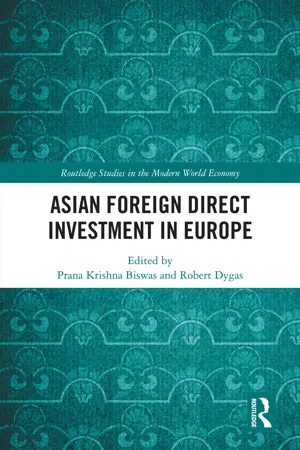
Asian Foreign Direct Investment in Europe
Prana Krishna Biswas, Robert Dygas, Prana Krishna Biswas, Robert Dygas
- 168 Seiten
- English
- ePUB (handyfreundlich)
- Über iOS und Android verfügbar
Asian Foreign Direct Investment in Europe
Prana Krishna Biswas, Robert Dygas, Prana Krishna Biswas, Robert Dygas
Über dieses Buch
This book analyses the most recent trends in Foreign Direct Investment from the major Asian economies to the EU, focusing on China and Japan's FDIs in the EU, and Poland in particular. The authors assert that, from a European perspective, there is a strong need for further Asian FDIs into EU nations, which will establish mutual benefits.
This is the first book to explore the outflow of FDI from Asian nations to other countries, especially to EU member states, whereas the extant literature focuses on the inflow of FDI to Asian nations. The authors analyse a multidimensional range of issues, covering macroeconomics, finance, technology, and examine the governments, local authorities, and institutions that support such investments. FDI has an instrumental role in the development of host countries. Large-scale capital flow becomes a vehicle for providing foreign technology, knowledge, skills, and other inputs for the integration with international marketing, production, and distribution networks and for improving the economic competitiveness of firms and economic performance of the host country.
The analysis in the book is presented using statistical and econometrical approaches, emphasising a profound level of investigation, which will be particularly useful for graduate and PhD students of International Economics, Business and Trade.
Häufig gestellte Fragen
Information
1
Research literature analysis on FDI and FDI flow between Asia and the EU member states
1.1 Introduction
1.2 Composition of the research literature

| Theoretical constructs emerging through literature | Literature |
|---|---|
| | |
| Eclectic paradigm or OLI (ownership, location, and internalisation) model of FDI | Dunning (1970), Hymer (1972), Dunning (1979), Dunning (1988), Denisia (2010), Mateev(2014) |
| Internationalisation approach of FDI Internalisation occurs when firms perceive the benefits of external investment being greater than that of the cost involved. The process involves knowledge and technology flows by linking them to improved production efficiency from an upstream production facility to a downstream facility or vice versa | Hymer (1972), Findlay (1978), Mansfield and Romero (1980), Hennart (1982), Borensztein et al. (1995), Kokko (1994), Kokko et al. (1996), Dent (1999), Rodrik (1999), Shatz and Venables (2000), Smarzynska, (2002), Alfaro (2003), Ramachandran(2004), Tolentino (2008), Denisia (2010), Subramanian et al. (2010), Herzer (2011), Ahmed (2014), Dhar and Wani (2017), Hertenstein et al. (2017) |
| Institutional approach of FDI The approach links the institutional variable like economic, financial political, and judicial institutional set up, with the FDI flows | Kobrin (1976), Hennart (1982), Moran (1998), Lim Ewe-Ghee (2001), Gorgulu (2015), Baier andWelfens (2019), Abotsi(2018) |
| Resource-based approach or spring board approach of FDI The approach suggests that FDI decision of a firm is guided by its international and management experience and competencies, resource capabilities, and environmental necessities | Luo and Tung (2018), Tolentino (2008), Pradhan(2008),Ali etal. (2018), Luo and Tung (2018) |
| Linkage, leverage, learning approach of FDI This approach looks at firm-specific advantages of emerging market multinationals and suggests that the international expansion of emerging market multinationals is driven by resource linkage, leverage, and learning | Mathews (2006), Andres et al. (2013), Morris and Jain (2013) |
| CAGE distance approach of FDI The approach identifies that the cultural, administrative, geographic and economic differences, or distances between countries can be used to understand patterns of trade, capital, information, and people flows | Ghemawat (2001), Dent (2001), Bitzenis (2004), Wei and Andreosso-o'callaghan (2008), Witkowska (2009), Morris and Jain (2013), Witkowska (2013), Roman and Vasile (2018) |
| Strategic asset-seeking orientation It emerges that the intent of seeking strategic assets is a determining factor in explaining the FDI made in developed markets by the emerging market MNEs | Pradhan (2008), Yang et al. (2014), Meyer and Peng (2016), Hertenstein et al. (2017), Ramon et al. (2017), Haasis et al. (2018) |
| Economic growth and income inequality and FDI | Alter (1994), Blomstiom et al. (1994), Lipsey (2002), Gorg and Greenaway (2002), Tytell and Yudaeva (2005), Herzer and Schrooten (2007), Kowalewski and Weresa (2008), Wang (2009), Balgar and Dragoi (2014), Kurecic (2015), Alili (2015), AH (2017), Dhar and Wani (2017), Okara (2018), Escobar and Muhlen (2018), Sultanuzzaman et al. (2018), Jurcic et al. (2020), Sayed Hasant Shah et al. (2020) |
| Exchange rate movement and FDI Taxes, subsidies and FDI Export and import and bilateral treaties and FDI | Aliber(1970), Cushman(1985) Baltzer and Hansen (2011)Camarero and Tamarit (2003), Andreosso-O'Callaghan and Nicolas (2007), Bankole and Adewuyi (2013) |